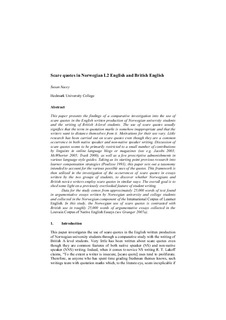| dc.description.abstract | This paper presents the findings of a comparative investigation into the use of scare quotes in the English written production of Norwegian university students and the writing of British A-level students. The use of scare quotes usually signifies that the term in quotation marks is somehow inappropriate and that the writers want to distance themselves from it. Motivations for their use vary. They may, for example, allow the writer to express irony or disagreement with the chosen term, despite this expression being the generally accepted one. Alternatively, such quotes are sometimes used to indicate that the writer is uncertain whether the expressed term is indeed the correct one. In terms of pragmatics, the former use has been characterized as secure and the latter as insecure usage (Pullum 2005). Little research has been carried out on scare quotes even though they are a common occurrence in both native speaker and non-native speaker writing. Discussion of scare quotes seems to be primarily restricted to a small number of contributions by linguists in online language blogs or magazines (see e.g. Jacobs 2003, McWhorter 2005, Trask 2000), as well as a few prescriptive admonishments in various language style guides. Taking as its starting point previous research into learner compensation strategies (Poulisse 1993), this paper sets out a taxonomy intended to account for the various possible uses of the quotes. This framework is then utilized in the investigation of the occurrences of scare quotes in essays written by the two groups of students, to discover whether Norwegians and British novice writers employ scare quotes in similar ways. The overall goal is to shed some light on a previously overlooked feature of student writing. Data for the study comes from approximately 25,000 words of text found in argumentative essays written by Norwegian university and college students and collected in the Norwegian component of the International Corpus of Learner English. In this study, the Norwegian use of scare quotes is contrasted with British use in roughly 25,000 words of argumentative essays collected in the Louvain Corpus of Native English Essays (see Granger 2007). | no_NO |
